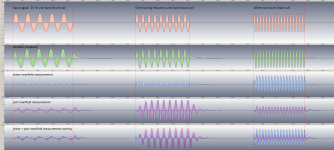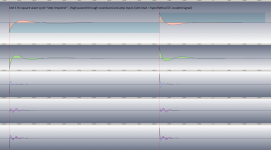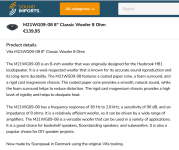I just realized I have to correct myself a little bit.Guess what? They both do, just look at the group delay 😉
It only "shifts" the other way around.
So one will add a shift from +180 to 0 degrees, while to other one does from 0 degrees to -180.
±180 degrees is obviously only for a 2nd order system.
This will change depending on the order of the system, starting at ±90 degrees for a 1st order system.
Which btw, @Tenson is also a way of finding out how much something is delaying or out of phase.
You just look at the slope and polarity of both systems, so the port as well as the driver+cabinet in this case
here is a (very big, zoom in to view details) image with these signal traces:
(image split up due to forum max image width restriction)


some remarks:
- source signal: 25 Hz sine burst (1 octave below tuning), 50 Hz sine burst (BR tuning frequency), 100 Hz (above tuning), one cycle of a 1 Hz square wave (quasi step response, note that the soundcard output is not DC coupled, so a strong highpass effect is visible! theoretical output as overlay
- loopback signal taken from the amp output
- driver output nearfield measurement
- port output nearfield measurement
- driver and port output overlay
(image split up due to forum max image width restriction)


some remarks:
- polarity should now be correct for the speaker!
- port has a lower surface than the driver Sd, can be seen for the 25 Hz signal: port is slightly stronger, 180 out of phase.
- the 25 Hz port signal is not symmetrical and somewhat distorted. but it's not audible anyway - cancelled out by driver and port being 180° out of phase. the harmonics however are probably audible!
- all port signals show a roughly 2 cycle tuning frequency trail, mostly visible at the "step response", but also at the end of the 25 and 100 Hz burst.
Last edited:
OK, Amazing that a woofer designed before 1988 is still in production, or is it available as old stock? Regardless, not a viable driver for putting in a modern design. I would really like to have a driver with a modern linear BL motor, shorting rings and, a nice oversized spider with high compliance. I want the best of both worlds, old and new. Nobody offers that. M21G-09 Data Sheet
Visaton have one that totally blows the sealed aren’t efficient trope out the window. B200 with 96db efficiency. https://www.parts-express.com/pedocs/specs/292-664--visaton-b200-spec-sheet.pdf
The Seas King RO4Y is sealed, both woofer and mid. https://www.madisoundspeakerstore.c...-kingro4y-mk-iii-active-loudspeaker-kit-pair/
Peerless SLS 830667, 8" Paper Cone Woofer. On sale $55. I’m very tempted to buy four! https://www.madisoundspeakerstore.com/approx-8-woofers/peerless-sls-830667-8-paper-cone-woofer/
Last edited:
OK, Amazing that a woofer designed before 1988 is still in production, or is it available as old stock? Regardless, not a viable driver for putting in a modern design. I would really like to have a driver with a modern linear BL motor, shorting rings and, a nice oversized spider with high compliance. I want the best of both worlds, old and new. Nobody offers that. M21G-09 Data Sheet
There are definitely options. But you need to define your goals. How big a box can you tolerate, low do you need to go, and how dynamic does it need to be?
Now gone
Tymphany P835016/7 (10"/12" 4 ohm, alu cone, as above
Peerless/Tymphany SLS 830667/8 8/10" paper cone, alu ring, geometric x-max 9 mm
I have all these above ^^^
In stock- get it whilst you still can.
Dayton RSS315HF or RSS315HFA-8 (12" 4ohm or 8 ohm) (Taiwan) previously US$120 now US$220
SEAS L26ROY/3 (10" 4ohm, alu cone copper cap)/black (Norway) previously $/€300, now $/€500
Scan-Speak 26W/8(4)534 - 10" 8 ohm (4 ohm) fibreglass cone, alu ring US$200
Scan-Speak 26W/30W4558T - 10/12" 4 ohm alu cone, geometric 12.5mm x-max, alu ring $250/$400
Scan-Speak 28W/32W4878T (11"/12.5" 4 ohm, geometric 14mm x-max - US$600/700
Purifi PTT10.0X04NAB- 10"" 4 ohm, alu cone, copper caps, neutral surround, geometric 14.75 mm x-max US$800
Things that went away because people didn't buy it (not enough demand)
Dayton Audio RSS390HE-22 15" 4 ohm alu cone, copper and alu, geometric ~1" x-max
Upcoming
SB Audience 18SW1900D- 18", 8 ohm, 17.5mm max, alu ring...
Last edited:
Arthur,Visaton have one that totally blows the sealed aren’t efficient trope out the window. B200 with 96db efficiency. https://www.parts-express.com/pedocs/specs/292-664--visaton-b200-spec-sheet.pdf
You are confusing on axis sensitivity with efficiency.
The Visiton B200 nominal 6 ohm "full range" loudspeaker is only four ohms over much of it's usable range as a woofer.
2.83v is 2 watts into four ohms.
Disregarding the 2-3dB gain over a 2volt input equivalent to 1watt/1m, it's sensitivity is ~96dB at 2000Hz where its dispersion "beams" at 60 degrees.
It's 2.83v sensitivity drops to only 80dB at it's Fs of 40Hz.
Reaching its (over..) rated Xmax of 3.42mm and power rating of 40 watts it could max out at ~90dB at 40Hz in a large sealed enclosure.
Not bad for a sealed 8", but not blowing any windows out 😉
Art
Peerless SLS woofers are good for sealed large boxes. Some sizes are NLA. I managed to buy four unused second hand SLS12 a year ago!
Peerless XLS woofers' Qts is better suited for reflex and they have higher Xmax
Search also for subwoofers! Most of them work really well up to 5-600Hz, perfect for 3-way small actives! SEAS L26ROY models eg.
https://data-bass.com/#/drivers?_k=2qnduh
https://loudspeakerdatabase.com/
Peerless XLS woofers' Qts is better suited for reflex and they have higher Xmax
Search also for subwoofers! Most of them work really well up to 5-600Hz, perfect for 3-way small actives! SEAS L26ROY models eg.
https://data-bass.com/#/drivers?_k=2qnduh
https://loudspeakerdatabase.com/
Last edited:
I would really like to have a driver with a modern linear BL motor, shorting rings and, a nice oversized spider with high compliance. I want the best of both worlds, old and new. Nobody offers that. M21G-09 Data Sheet
What kind of speaker are you looking to design? Air as the spring with a floppy cone isn't mechanically wise with the longer stroke of modern drivers which also leads to the air spring not being particularly linear. If the design requires a small sealed volume and a modern driver with a well controlled large displacement then EQ and a modern powerful amplifier is what is typically done. It is likely to deliver a better performance and mechanical reliability than a driver with a floppy cone though this may depend on the kind of speaker.
There is still the possibility to have drivers manufactured to ones specs:
https://audiotechnology.dk/
Not very cheap though .....
Regards
Charles
https://audiotechnology.dk/
Not very cheap though .....
Regards
Charles
Lavoce ssf102.40
Just for low frequency use, but it's not expensive and has reasonable Xmax and high power capability.
Just for low frequency use, but it's not expensive and has reasonable Xmax and high power capability.
Keep the "PA excursion numbers" in mind.Just for low frequency use, but it's not expensive and has reasonable Xmax and high power capability.
(Hvc - Hg) / 2 = (20.5-8)/2 = 6.25mm xmax
Which is okay for a 10 inch midwoofer, but low for a subwoofer.
Yes, and the same does also account for the aforementioned SB Audience 18SW1900D. But it is reasonably priced and therefore one could double-up on the amount of drivers. It doesn't have a very low Qts which helps when it comes to cloised-box applications.
Regards
Charles
Regards
Charles
The manufacturer says it’s the “mean sound pressure level”. I’m assuming that’s at the standard 2.83V at 1M on a standard baffle. Put it in a box and you will get some lift an octave up from resonance which brings it back to 90 db.Arthur,
You are confusing on axis sensitivity with efficiency.
The Visiton B200 nominal 6 ohm "full range" loudspeaker is only four ohms over much of it's usable range as a woofer.
2.83v is 2 watts into four ohms.
View attachment 1313349
Disregarding the 2-3dB gain over a 2volt input equivalent to 1watt/1m, it's sensitivity is ~96dB at 2000Hz where its dispersion "beams" at 60 degrees.
It's 2.83v sensitivity drops to only 80dB at it's Fs of 40Hz.
Reaching its (over..) rated Xmax of 3.42mm and power rating of 40 watts it could max out at ~90dB at 40Hz in a large sealed enclosure.
Not bad for a sealed 8", but not blowing any windows out 😉
Art
All that aside where are efficiency and sensitivity defined? The manufacturers often cloud the two. I would think efficiency should be in percent, 1 watt in .5 watts out is 50%.
- Home
- Loudspeakers
- Multi-Way
- Why are sealed box woofers out of fashion
